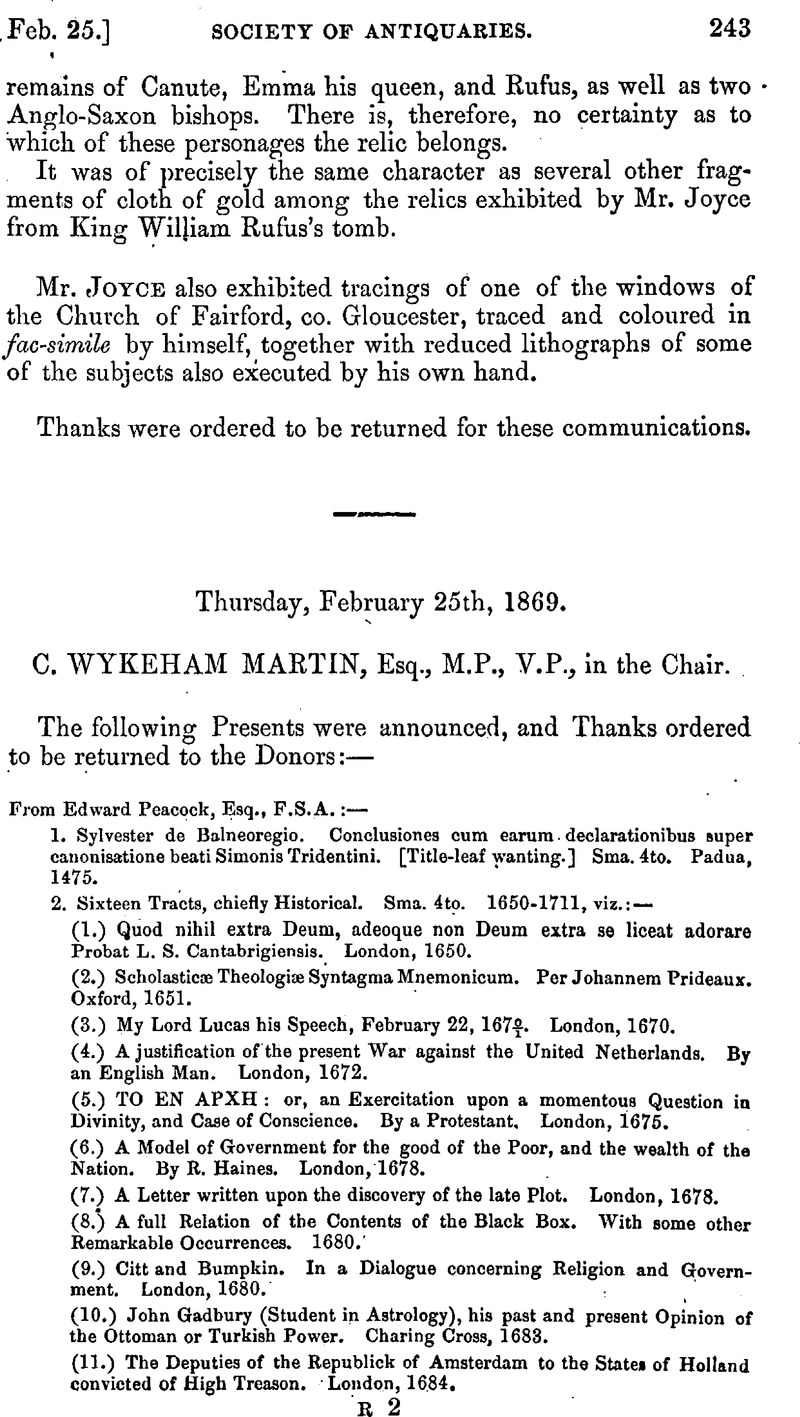No CrossRef data available.
Article contents
Thursday, February 25th, 1869
Published online by Cambridge University Press: 10 May 2010
Abstract

- Type
- Proceedings
- Information
- Copyright
- Copyright © The Society of Antiquaries of London 1870
References
page 247 note * “Dorsetshire. Its Vestiges, Celtic, Roman, Saxon, and Danish.”
page page 247 † B. G. lib. iv.
page 247 note ‡ p. 151. Ed. 1594.
page 248 note * Aubrey MSS. pt. ii. p. 64.
page 248 note † MS. pt. ii. p. 60. These ditches are manifestly one andthe same, i.e. Bokerley Dyke, for Grimsditch is on the north-west of Martin, and Bokerley on the south, whilst the latter forms the boundary between the counties of Dorset and Wilts.
page 248 note ‡ The “Seven Ditches” of Aubrey belong to Vindogladia; they are simply British trackways converging on that ancient British town, as may be seen on referring to my archæological “Map of Dorset ;” but conclusive evidence is afforded by the fact that the name of “Seven Ditches” is still applied by the peasantry to that remarkable series of earthworks on Gussage Down, where Sir R. C. Hoare identified the lost station of Vindogladia. Furthermore Dr. Smart informs me that in the Register of Cranborne Church is the following entry:——
“1613. The 16th day of Marche was buryed a woman weh dyed in the snowe at Seven Ditches.”
Monkton up Winborne, being the nearest hamlet to the spot where the body was found, is in the parish of Cranborne, which accounts for the interment taking place there.
page 248 note § MS. pl. ii.p. 65.
page 248 note ‖ Ibid.
page 249 note * Aubrey refers to a line drawn on his map from Alvediston southward to the east of Badbury and Winborne, and near to Knolton [imaginary].
page 249 note † See Asser's Life of Alfred, A.D. 876.
page 250 note * Wansdyke, according to Hoare, was a work of two distinct nations, but he does not attribute it to the Belgæ. His admeasurement gives it at 37 feet from the bottom of the fosse to the top of the vallum, and 15 feet on the other side. Bokerley Dyke measures from the fosse to the apex 43 feet, and in some places 50 feet, with from 23 to 30 feet on the other side from the top to the level; this from my own measurement.
page 250 note † Stukeley, Stonehenge, p. 4.
page 250 note ‡ Warton, A.D. 1728–1790.
page 251 note * Hutchins' Dorset, i. 132.
page 252 note * Archæological Journal, viii. 146.
page 253 note * This dyke, or rather these dykes are very peculiar in their construction, consisting of a triple row of “valla” with intervening “fossæ ;” the central vallum being the strongest. They differ from all others in Dorset, which consist generally of a vallum and fosse. A parallel example was discovered by Sir R. C. Hoare (Ancient Wilts, vol. i. Station vi. Everley, p. 189), whose curiosity was excited, as it differed materially from any he had previously noticed.
page 253 note † See an essay in “Wareham, the Age of its Walls,” by C. Warne, in the Gentleman's Magazine, September, 1865.
page 254 note * Penny Cyclopædia, ‘Belgæ.’




